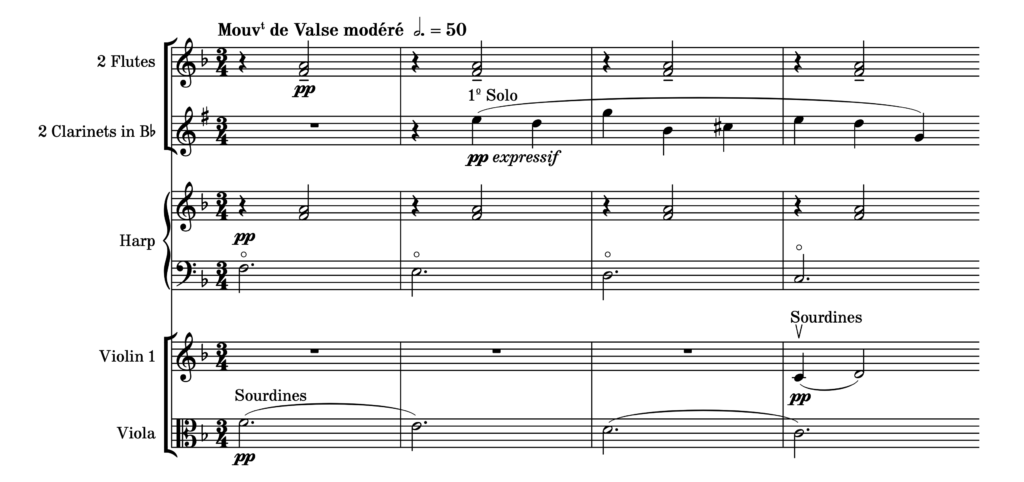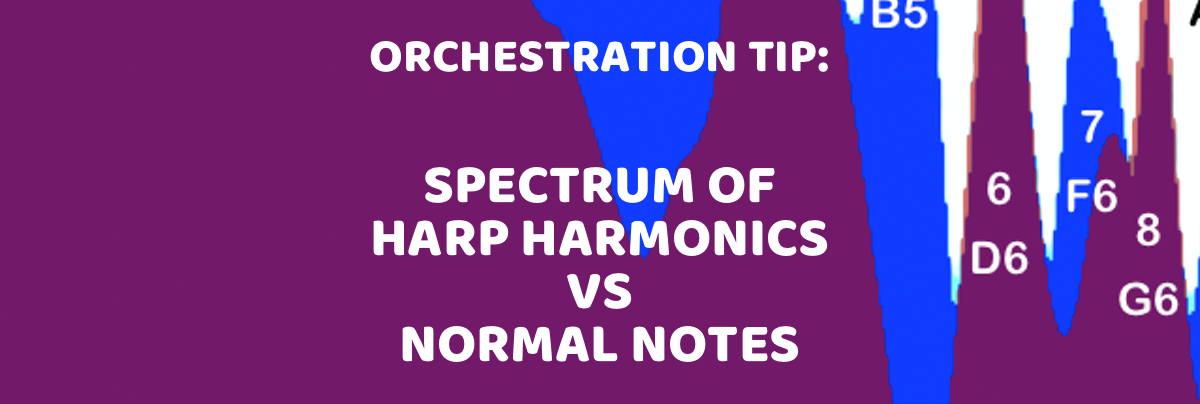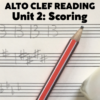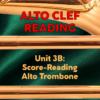Comparing the spectrum of normally played harp notes with harmonic tones reveals a wealth of information useful in understanding dynamics, contrasts, and quality of timbre.
The poetic, bell-like tone of harp harmonics is a magical effect. The scores of composers like Ravel and Holst contain beautiful examples, carefully highlighted in ways that draw the attention of the listener intimately inwards. But it’s so easy to get it wrong as well. I’ve analysed many scores lately that treat harmonic harp tones the same as normal tones in weight, technique, and character. Technique is subject of its own – but in terms of weight and character, all we have to do is compare the spectrum of normal and harmonic tones. Right away, you’ll see the difference in strength, resonance, and timbre that will hopefully guide you toward a more apt approach.
Before we get into comparisons, though, let’s start by looking over the spectrum of a normal harp note, in this case play at mf on the pitch of G3. The first thing you may notice is that harp timbre is essentially the opposite of brass. While brass instruments tend toward a weak root and then stronger body of tone (partials 2-4), harp has a decidedly powerful root, standing high above the other partials that follow it on the chart below. The body of tone is still more or less rich, if slightly subdued; while the sheen of the tone (from the 5th partial upward) falls off rather quickly, if spikily on the chart. This spectrum is what gives harp its limpid, golden timbre. A stronger body of tone would make the harp sound more trebly, while a bulging sheen from the 6th to 16th partials would give it a more “nasal” quality. But the steady downward slope of the spectrum keeps the strength at the base of the pillar, as it were.
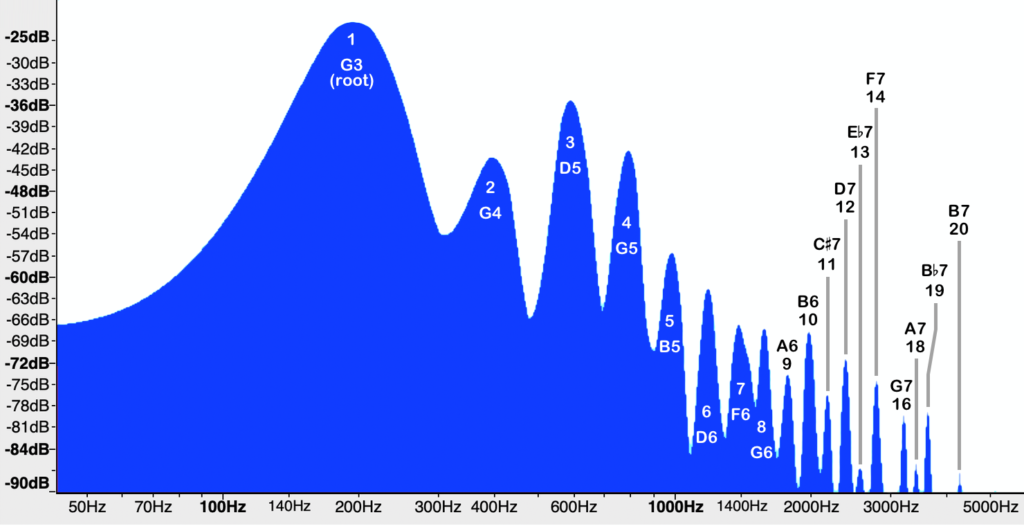
To quickly review, harpists play harmonics nearly 100% of the time* by resting the palm of the hand at the octave node at the halfway point of the string, and then plucking above it with the fingers. These notes are written with a circle above the notehead, which by the harpist’s preference should indicate the string played, sounding an octave higher. As I’m sure many readers have heard me complain, notation applications such as Sibelius have their playback to sound at the pitch written, which often goes right through the chain of proofing and editing to the harpist’s music stand, leaving them to guess whether the note indicated is meant to sound at the pitch written or an octave higher. Please, please edit this quirk out of your scores and deliver your harpists parts intended to sound an octave higher. That is the safest result – for you as much as them.
So let’s look at an example of just that: the same string of G3, plucked as a harmonic, sounding an octave higher – overlaying the spectrum chart in the first example. As you might expect, the harmonic (in red) suppresses the root of the G3 string – but what might be more surprising is the greater emphasis on the 2nd partial, turning it into the new root of a pitch sounding an octave higher. From there, the harmonic skips every other spike – nearly all the odd-numbered partials – and creates a whole new spectrum of tone out of the even-numbered partials. Thus, if the 2nd partial is the new root, then the 4th-to-8th partials become the new body of tone, simulating 2nd-to-4th partials – and so on.
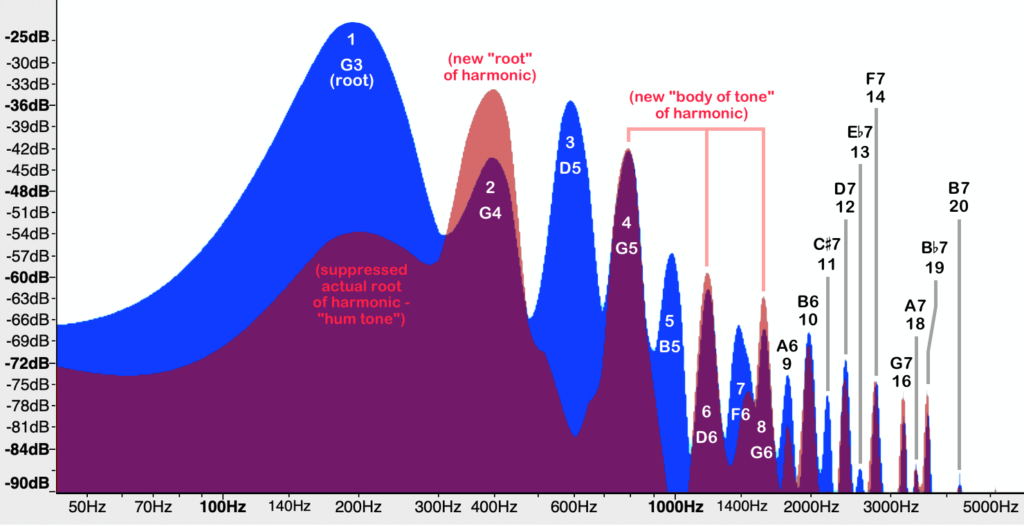
Notice the suppressed root – which, while much weaker than normal, still plays a role. The spike on the 2nd partial will drown out much of the surface audibility of that root – but the damped-down bulge is still stronger than most of the body and sheen of the harmonic tone. This contributes much of the bell-like character, operating similar to the hum tone of a bell: hanging in the air under the “strike tone” of the new root on the 2nd partial. Interestingly, this same “hum tone” is produced an octave below any normally played harp note, but it’s much much weaker than the proportions illustrated above. Yet it also helps to shape some of the naturally chiming timbre of a plucked string.
Something that the above chart doesn’t illustrate so well is how the artificially produced new spectrum of tone is somewhat weaker on some partials compared to the proportions of a normal note. Thus, I’ve generated a third example below, overlaying the original normally-played note of G3 with a harmonic tone on the same pitch, played on the string of G2 an octave below. While this doesn’t show the “hum tone,” you can still see the red curve of the harmonic waveshape to the left of the chart in a much higher position than the blue curve below it. This red curve eventually rises again to a position higher than the body of tone on the root of the plucked lower string. But that’s not really the purpose of this chart. Instead, observe the general layout of how the harmonic tone spikes above the normal note’s root tone – and then falls below the normal curve for most of the higher partials that follow. I’ve marked the partials of the harmonic tone in red type, below the white type of the normal note’s partials. The even-numbered spikes simulate a new tone using the 2nd partial of the harmonic as the root, just as we saw in Example 2 – and yet you can see little bulges on odd-numbered partials here in there, like the 11th and 17th partials. These stray odd partials also contribute to the bell-like tone, by adding complexity which is absent from a normal note. But the main thrust here is the much weaker body of tone on the 2nd-to-4th (harmonic 4th, 6th, and 8th) partials. This further suppression of an already comparatively weaker resonance is what makes harmonics so easily covered by any kind of distraction in orchestral scoring. Interestingly, the lower sheen of the harmonic tone approaches the same strength as a normal note, even surpassing it on some partials. So the radiance above continues to glow.
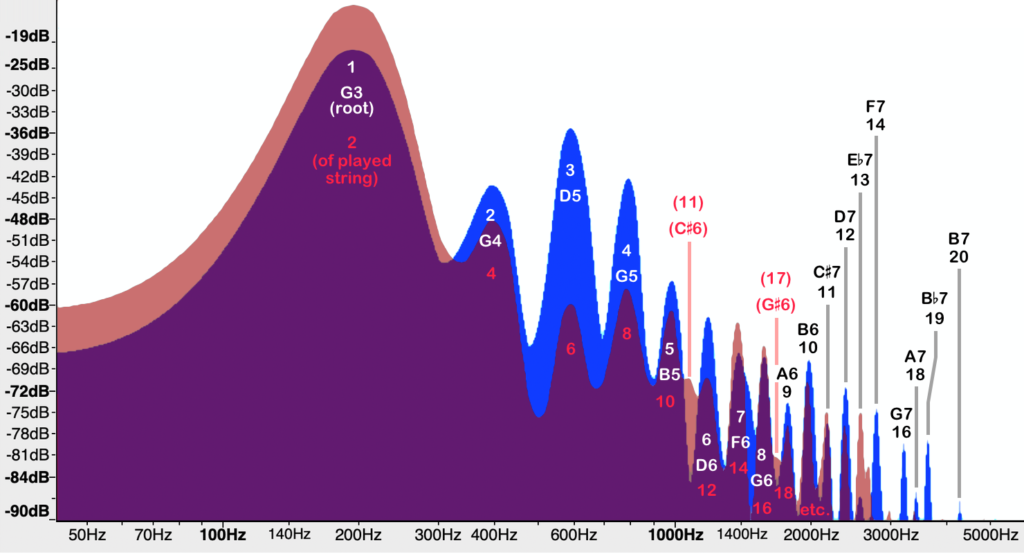
The implications of all the above are enormous for the orchestrator. Consider just how easy it would be to score a passage in a way that swallowed some of the subtleties and character of harp harmonics. All it would take would be a penetrating note sounding an octave below on horn or clarinet to absorb the hum tone, leaving the harmonic sounding weak and inconsequential. Just as pernicious would be any pitch-weight by the orchestra that sat vibrantly over the harmonic’s weakened body of tone. That might make the entire note invisible, or at least pale and lifeless. And yet understanding the pecularities of the harmonic’s wave-shape might lead to very inspired combinations of tone by the orchestra that beautifully highlight the effect. For instance, in the following opening to the Beauty and the Beast movement of Ravel’s Ma Mère L’oye, we see a simple descending line of harmonics in the harpist’s left hand, doubled by soft muted violas. The harpist’s right-hand F 3rds are doubled by delicate low flutes, keeping well out of the way of the radiance of the left-hand harmonics. Meanwhile, the clarinet above blithely plays over the melody. In four bars, Ravel elegantly sets the scene and introduces the main character of Beauty.
